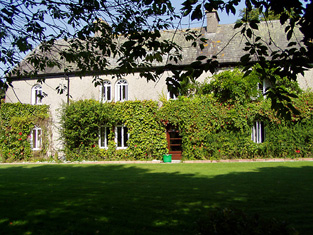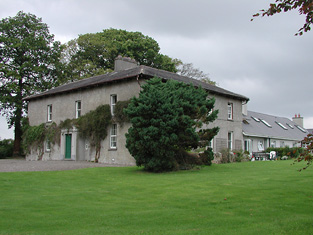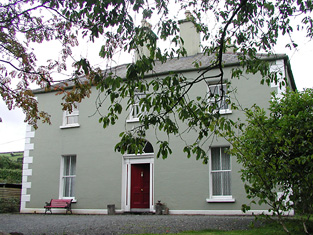Kilboy
Houses within 5km of this house
Displaying 11 houses.
Houses within 5km of Kilboy
Displaying 11 houses.
| House name | Description | |
|---|---|---|
| Monaquil | Burke's ''Landed Gentry of Ireland'' (1904) records Philip Going of Monaquil, sixth son of Robert and Jane Going. In 1767 Philip married Grace Bernard. Their grandson, Reverend Philip Going Atkins Going, succeeded to the Monaquil property by the will of his maternal grandfather, who died in 1820. Monaquil was occupied by the Atkins family in 1837. In 1840 the Ordnance Survey Name Books record that "Mr. O'Shea, proprietor, states that he has nothing to do now ith Monaquil, it is under the Courts" and that the house was then occupied by a Mrs. Bennett. It was vacant at the time of Griffith's Valuation. when Reverend Hastings Atkins was the immediate lessor and the house was valued at £19. The Butler sale rental of 1866 records a fee farm grant dated 19 May 1859, John Butler to Reverend Philip Going Atkins Going. The Atkins sale rental of 1877 records the leasing of Monaquil to Robert William Henry Roe in 1864. The original house marked on the first edition Ordnance Survey Map was replaced by another house slightly to the north in the late 19th century. | |
| Debsborough | The seat of the Bayly family in the 18th and 19th centuries, occupied by successive John Bayly/Bailys and held in fee. The Ordnance Survey Name Books describe it as "a large demesnewith commodious dwelling house" in 1840. In the mid 19th century the house was valued at £38+ and in 1906 at £65. A building is still located at this site. | |
| Ballynaclogh House | The home of Richard Uniacke Bayly and his family in the 19th century, held from his brother John. The house was valued at almost £17 at the time of Griffith's Valuation. This house is still extant and occupied. |

|
| Bayly's Farm | The home of Lancelot P. Bayly and his family in the 19th century, held from his brother John. The house was valued at £13.6 shillings at the time of Griffith's Valuation. This house with modern additions still functions as a residence. It also offers guest accommodation. See www.baylyfarm.ie. |

|
| Coolagh | Coolagh is described in the Ordnance Survey Name Books as "a good dwelling house in a small demesne with plantation and ornamental ground" in 1841. It was occupied by John Brindley in the mid 19th century. Valued at £12+ it was held from the Very Reverend Dean Head. It is still extant. | |
| Happygrove House | In 1840 the Ordnance Survey Name Books refer to "Happy Grove" as "the name of the place and residence of Mr. John Brindley" and gives details of the oatmeal mill in the demesne. Samuel Brindley was the proprietor of a corn mill and house at Clonmore in the mid 19th century. He held the property from Lord Dunalley and the buildings were valued at £35. The house no longer exists. | |
| Traverston | Traverston was the seat of the Going family in the 18th and 19th centuries. In 1786 Wilson refers to it as Trevor's-town, the seat of R.Going. It was the residence of Thomas Going in 1814 and 1837. The Ordnance Survey Name Books describe it as "a splendid residence" in 1840. In the mid 19th century Caleb Going occupied the house and held the property in fee. The buildings were valued at £52+. Still valued at £52 and occupied by John R. Lloyd in 1906. John R. Lloyd was the son of Anne, daughter of Robert Going of Cragg, Newport, who, in 1828, married Edward Lloyd of 12 Upper Mount Street, Dublin. John R. Lloyd died unmarried in 1910 and left Traverston to his niece, Ann Norris. This house is now demolished. see http://www.glendafae.com/histories/Going%20of%20TRAVERSTON.pdf | |
| Lissenhall | In 1786 Wilson mentions Lissen-Hall as the seat of Mr. Otway. Mr Thomas Devoy occupied Lissenhall in 1814 and in 1837 Rowan P. Cashel was resident. Margaret Dagg held the house valued at £42.13 shillings from the Honourable Mrs Otway Cave at the time of Griffith's Valuation. Lissenhall dwelling house and 242 acres bought for £5000 by William H. Carrol in 1853. In 1906 the mansion house in Lissenhall townland was valued at £30 and occupied by Alice J. Carroll. This house no longer exists. | |
| Ballyquiveen | A house built post the first edition Ordnance Survey map of circa 1838. John Brindley was leasing a house from Dean Head valued at £5+ at Ballyquiveen at the time of Griffith's Valuation. It is no longer extant. | |
| Tulla | Tulla House was the home of the Carroll family in the 19th century. William Carrol was resident in 1814 and Major General Sir Parker Carrol in 1837. Captain W. H. Carrol held the house valued at £20+ and townland in fee at the time of Griffith's Valuation. The house valued at £18 was still occupied by the Carrols in 1906. A house is extant at the site. | |
| Silvermines Cottage | In 1840 the Ordnance Survey Name Books describe Silvermines Cottage as "a neat and comfortable cottage, the residence of Rowan P. Cashell". He was also the occupier at the time of Griffith's Valuation, leasing from Lord Dunalley's estate. The property was valued at £10 15s. The National Inventory of Architectural Heritage states that it was, for a time, the mine manager's house, for the nearby mines. Silvermines Cottage is still extant and well-maintained. |

|

